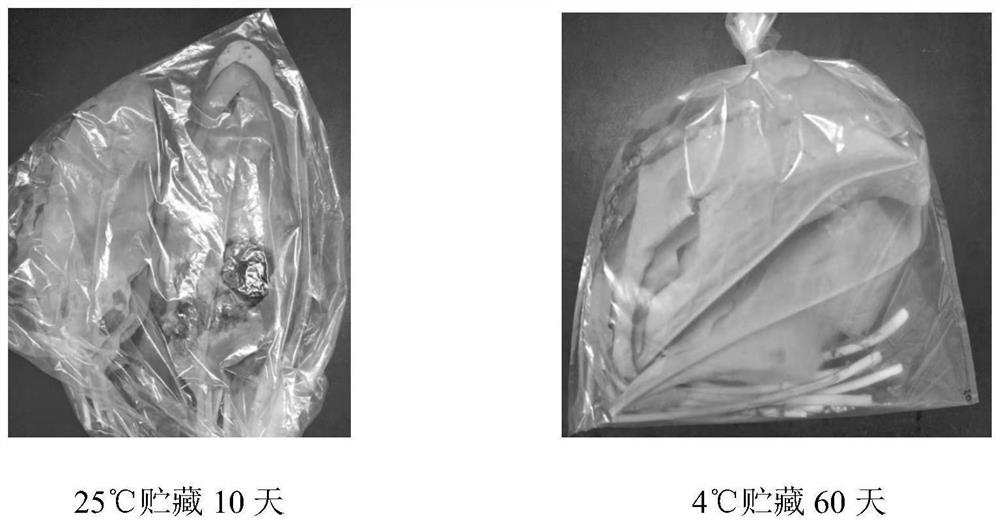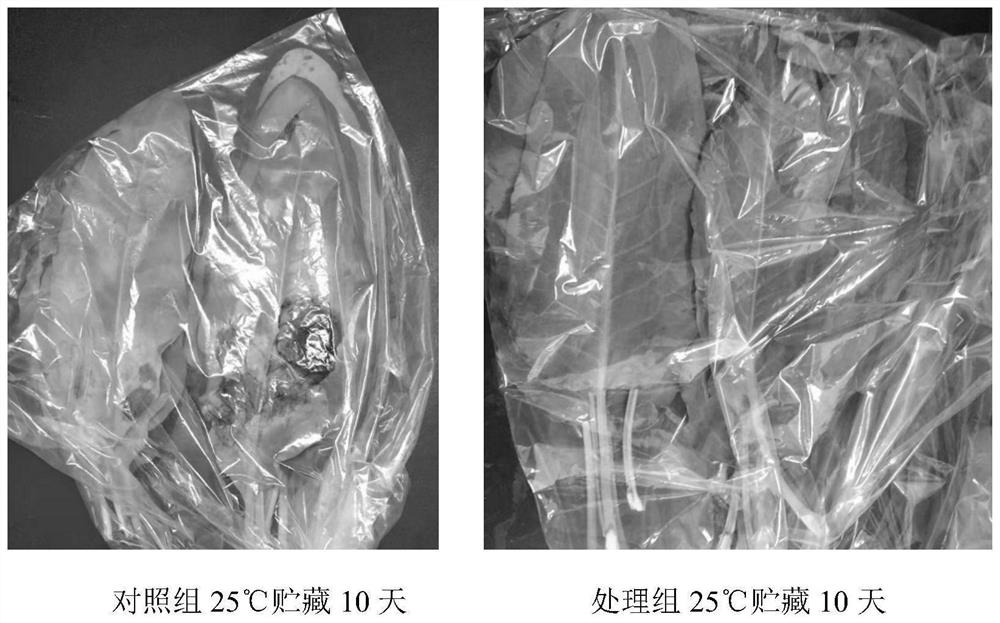Fresh-keeping method of rumex hanus
A fresh-keeping method and leaf-eating grass technology, applied in the field of fresh-keeping, can solve the problems of easy water loss, shortened shelf life, fragile tissue, etc., and achieve the effects of delaying aging and improving the effect of fresh-keeping
- Summary
- Abstract
- Description
- Claims
- Application Information
AI Technical Summary
Problems solved by technology
Method used
Image
Examples
Embodiment 1
[0027] Choose a vegetable leaf leaves that are harvested, no mechanical injury and pests and pests; uniform spraying preservation agents, the preservative contains 0.05% propionic acid, pyropopyneua 30 ppm, adenosine The concentration of triphosphate is 10 ppm. The preparation method of the preservation agent is to add propionic acid, chloropyripateneutin, adenosine triphosphate to water in water, mix well, and mix well. Then the food-treated eaters were dried; the treated eaten herbs were loaded into a polytetrafluoroethylene microporous film having a thickness of 0.03 mm, and the final concentration was 10 ppm 1-A Base cyclic propylene, tighten the bag, stored at 25 ° C. It is carried out for storage preservation of eating leaves by the method of the present invention, and can be stored for 10 days at normal temperature. Compared to the ratio 1, the rot rathe is reduced by 50%, and the yellowing rate is relatively reduced by 85%. image 3 ).
Embodiment 2
[0029] Choose a vegetable leaf leaves that are harvested, no mechanical injury and pests and pests; uniform spraying preservation agents, the preservative contains 0.05% propionic acid, pyropopyneua 30 ppm, adenosine The concentration of triphosphate was 50 ppm. The preparation method of the preservation agent is to add propionic acid, chloropopynen uretenena, adenosine triphosphate to the water according to its content, and mix well and uniformly prepare. Then the food-treated eaters were dried; the treated eaten herbs were loaded into a polytetrafluoroethylene microporous film having a thickness of 0.03 mm, and the final concentration was 10 ppm 1-A Base cyclic propylene, tighten the bag, stored at 4 ° C. It is carried out for 60 days of storage for 60 days by the method of the present invention, and after 60 days of low temperature conditions, the rot rat rate is reduced by 80%, and the yellowing rate of the blade is relatively reduced by 85%. Figure 4 ).
Embodiment 3
[0031] Choose a vegetable leaf leaves that are harvested, no mechanical damage and pest injury; the surface of the surface of the leaf is sprayed, the preservation agent contains 0.01% mass propionic acid, a chloropyrida 50 ppm, adenosine The concentration of triphosphate is 100 ppm, the preparation method of the preservation agent is to add propionic acid, chloropopynen uretena, adenosine triphosphate to water, mix well, and mix well. Then the freshly treated eating leaf is dried; the treatment of eaten leaves into a polytetrafluoroethylene microporous film having a thickness of 0.03 mm in the locking water, and the final concentration is 30 ppm 1-A Base cyclic propylene, tighten the bag, stored at 4 ° C. With the present invention, it was stored in a storage preservation of eating, and after 60 days of low temperature conditions, the rot ratio was reduced by 95% compared to the ratio 1, and the yellowing rate of the blade was relatively reduced by 95%.
PUM
 Login to View More
Login to View More Abstract
Description
Claims
Application Information
 Login to View More
Login to View More - R&D
- Intellectual Property
- Life Sciences
- Materials
- Tech Scout
- Unparalleled Data Quality
- Higher Quality Content
- 60% Fewer Hallucinations
Browse by: Latest US Patents, China's latest patents, Technical Efficacy Thesaurus, Application Domain, Technology Topic, Popular Technical Reports.
© 2025 PatSnap. All rights reserved.Legal|Privacy policy|Modern Slavery Act Transparency Statement|Sitemap|About US| Contact US: help@patsnap.com



